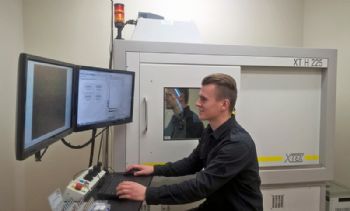
Ortho Baltic, a Lithuanian medical company based in Kaunas, is the first manufacturer of patient-specific temporo-mandibular joint endo-prostheses in the Baltic states (and one of only three in Europe).
Temporo-mandibular joints — TMJs — are the two joints connecting the jawbone to the skull, and the implants in question address loss of jaw movement.
To underpin their production, the firm invested (in 2012) in additive-manufacturing (AM) technology and recently acquired CT (computed tomography) inspection equipment from Nikon Metrology NV, Leuven, Belgium (
www.nikonmetrology.com), for quality control.
In its mission statement, Ortho Baltic cites two objectives: to move away from a ‘one implant fits all’ mindset towards tailored solutions; and to make patient-specific implants affordable and readily available for all patients and national health-care systems.
The company also designs and produces patient-specific joints, cranial and spinal implants, bone plating systems, dental and jaw restoration implants and surgical guides.
Ortho Baltic’s Implant Design and Development Centre uses various AM processes for the different types of components produced. Typically, implants are made from medical Grade-5 titanium alloy Ti6Al4V by direct laser metal sintering.
For its surgical guides and implant models, a biocompatible polymer — PA 2200 (also known as Nylon-12) — is laser sintered.
X-ray plays an important role in the process from start to end. Medical CT scans are the basis for preparing the CAD model, while inspection of AM parts is carried out with a Nikon Metrology industrial high-voltage micro-CT scanner.
Milda Jokymaitytė, a clinical engineer at Ortho Baltic, said: “To create anatomical models, our engineers use the patient’s radiological data to make a 3-D reconstruction; the anatomical bone structures are segmented, and virtual 3-D models are prepared. Including printing, quality control, packaging and sterilisation, the usual lead time for a patient-specific jaw-joint implant is approximately four weeks following the surgeon’s approval of the final design.”
In the medical field in particular, the quality, fit and functionality of AM implants and other medical components are vital.
Domantas Ozerenskis, product quality manager at Ortho Baltic, says: “Currently, micro-CT is the best solution for our product development and quality control. 3D-printing is a complicated technology, and there is a large variety of processing parameters, so it is very hard to predict the quality and geometry.”
The Nikon Metrology XT H 225 micro-CT scanner at Kaunas has a 225kV micro-focus source that reveals — non-destructively — any voids, cracks and other defects of the complex internal features of the AM components. Moreover, the scan data is compared against the original CAD design to highlight any deviations.
“Micro-CT scanning is the only way to check — non-destructively — for voids and cracks inside a part,” adds Mr Ozerenskis. “We considered a co-ordinate measuring machine, but it is incon-venient for taking non-parametric measurements — and there is no possibility for inner structure investigation. The internal quality of implants is very important, as it determines the mechanical strength of the part.”
Ortho Baltic needed at least a 200kV energy source to penetrate the dense materials it uses. Another requirement was for the system to have a large enough working area, as component sizes vary for each patient and procedure, so a platform capable of holding a range of large or heavy components was needed.
The Nikon Metrology XT H 225 met these requirements and was chosen by the medical company, together with a Varian 4030 digital panel and Inspect-X software.
The CT system is helping Ortho Baltic to make tailored implants affordable and easily available. Indeed, when compared to standard implants previously sourced from the USA, the company has been able to produce implants of the same high quality at almost half the cost.
Maxillofacial surgeon S Bojarskas said: “Apart from needing more extensive planning, the AM product itself is no different in terms of quality.”
In conclusion, Mr Ozerenskis said: “Nominal CAD to actual 3-D printed implant comparison, geometry inspection and void detection are essential aspects of our quality control.
“The Nikon solution offers better knowledge of what we are manufacturing and gives superior precision and understanding of 3-D printing errors and deviations.
“After 3-D metal printing, post-processes such as sandblasting and polishing often remove surface layers up to 200µm thick — even more in the case of other manual processes.
“What micro-CT data has also helped to do is adjust our CAD and 3-D printing protocols to get the most accurate geometry for all our AM parts.”